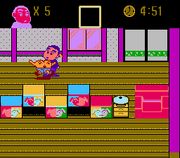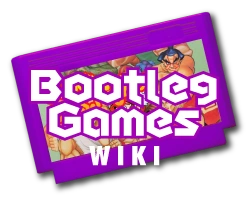No edit summary Tag: rte-source |
(Touch up on wording, fix grammar. Like any other Cony Soft game, this just uses Guo Qiyong's sound engine) Tags: Visual edit apiedit |
||
| Line 6: | Line 6: | ||
|console = NES/Famicom |
|console = NES/Famicom |
||
|date = 1995 |
|date = 1995 |
||
| − | |sound = |
+ | |sound = Guo Qiyong |
|alt = Crayon Shin-Chan 2 (cartridge label)|image = File:Crayon_Shin-Chan_(Ch)_-!--0.png}} |
|alt = Crayon Shin-Chan 2 (cartridge label)|image = File:Crayon_Shin-Chan_(Ch)_-!--0.png}} |
||
| Line 24: | Line 24: | ||
==Differences between original== |
==Differences between original== |
||
| − | *The original |
+ | *The original game is in Japanese. As the Future Media port was intended for Taiwanese audiences, the language for this version seen here is Chinese. |
| − | *The original |
+ | *The original game has an intro, while the port cuts it out. |
| − | * |
+ | *Stage 2 in the original game is platform-styled. However, Stage 2 in the Future Media version is another beat-em-up styled level. |
| − | *Some |
+ | *Some stages of the Future Media port are laid out differently from the original game. However, there are some exceptions in which (e.x. parts of Stage 1, Stage 3 and Stage 4) the layout for a stage is intact. |
| − | *The sub-stages of |
+ | *The sub-stages of Stage 4 are not present in this version. |
| − | * |
+ | *In the Future Media port, Stage 4 is called "A." |
| − | * |
+ | *For the Future Media port, unlike the original game, the player cannot use the Super Hero powerup and throw things at the same time. |
==Gallery== |
==Gallery== |
||
Revision as of 23:24, 6 May 2017
Crayon Shin-Chan (Chinese : 蠟筆小新 , pinyin :Làbǐ xiǎo xīn) is a pirate NES/Famicom port of Crayon Shin-Chan 2 : dai maō no gyakushū for SNES/Super Famicom, made by Cony Soft under the alias Future Media in 1995.
Overview

Gameplay
The game starts with the Future Media logo. Like all other games made by them, unlike the majority of NES/Famicom games, you use B to jump instead of A. The game itself is very simple. The player only needs to jump over the enemies in the levels. The game has 4 stages. The stage select allows the player to select the first three levels. Every stage has a boss. Once the first three stages are beaten, the fourth stage is accessible.
Credits
- Programming : Derek SUNG, Bill LIN
- Animation: David YEH, Terry CHENG
- Music : Victor LII
- Test: Super Soft Team Group
Differences between original
- The original game is in Japanese. As the Future Media port was intended for Taiwanese audiences, the language for this version seen here is Chinese.
- The original game has an intro, while the port cuts it out.
- Stage 2 in the original game is platform-styled. However, Stage 2 in the Future Media version is another beat-em-up styled level.
- Some stages of the Future Media port are laid out differently from the original game. However, there are some exceptions in which (e.x. parts of Stage 1, Stage 3 and Stage 4) the layout for a stage is intact.
- The sub-stages of Stage 4 are not present in this version.
- In the Future Media port, Stage 4 is called "A."
- For the Future Media port, unlike the original game, the player cannot use the Super Hero powerup and throw things at the same time.
